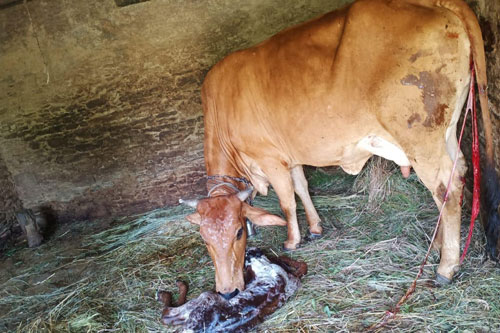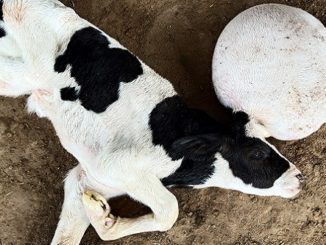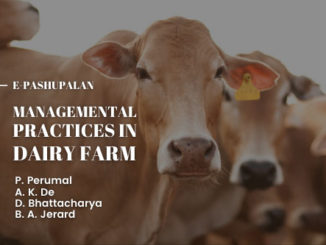Introduction
The prenatal period is the most hazardous in the life of all animals. The main causes of prenatal morbidity and mortality are, in descending order of importance, combined respiratory and metabolic acidosis, parturient trauma, congenital infections and deficiencies. Prenatal mortality may be defined as calf death before, during, or within 48 hours of calving, following a gestation period of at least 260 days, irrespective of the cause of death or the circumstances of the calving. Some 90% of calves that die in the prenatal period were alive at the start of calving, and so much of this loss is preventable. The prevalence of PM in dairy herds in the United States has increased in recent years and is currently 8%. This average figure obscures the fact that PM follows a right-skewed distribution in which most herds have none or minimal losses but some herds have high (25%) mortality. Prenatal morbidity and mortality are growing welfare concerns, given their impact not just on losses around calving but also on subsequent productivity, health, reproduction, and farm economics.
Management of the cow at calving
Calving supervision
Good supervision depends on monitoring calving, particularly stage two, and intervening if and where necessary, while avoiding excessive direct supervision. The continuous presence of an observer during stage two of calving has been associated with an increase in calving problems and assisted deliveries. Monitoring approximately every 3 to 6 hours from the first detection of the onset of stage one is advisable to detect the onset of stage two of normal calving and to detect abnormal calvings early. The duration of stage one of calving is highly variable among animals, and the onset and changes occurring, such as myometrial contractions, cervical dilation, and fetal repositioning, is largely not detectable. Hence, 6 to 12 hours of restlessness, box walking, and tail rising, and increased frequency of rising and lying down may occur. If, after approximately 6 to 12 hours (cows and heifers, respectively) of this behavior without undue disturbance, abdominal contractions have not commenced, an exploratory examination should be conducted. If cervical dilation has commenced and no abnormalities are detectable, monitoring should continue approximately hourly. The allantochorion ruptures approximately 1 hour before the amnion appears. Undue delay between the rupture of the allantochorion and the appearance of the amnion or fetal hooves may indicate a problem such as fetal oversize or maldisposition.

Calving assistance
Most cows are delivering without any assistance. However, a small number of cows and a greater proportion of heifers may require assistance. When the cow is first detected in stage two, an exploratory examination should be conducted that includes cow health (milk fever, mastitis); the integrity and contents of the amniotic sac; the disposition, vigor, and size of the calf; the degree of dilation of the vagina and vulva; and an assessment of how long the cow has been in stage two of calving. The amniotic sac may be ruptured or intact and normally contains milky white fluid, whereas mustard or brown fluid indicates meconium staining, red fluid indicates placental haemorrhage or late fetal death, fetid fluid indicates early fetal death, and cotyledons indicate premature placental separation. A vital calf will have strong interdigital, bulbar, lingual, swallowing, and anal reflexes. With increasing degree of acidosis, failure to show the interdigital reflex will precede failure to show the bulbar and swallowing reflexes. If the amnion or fetal legs are dry and cold, the cow has been calving at least 30 to 60 minutes. If indentations from the calf’s incisors are visible on the lower surface of a swollen upturned purple tongue, the calf has been stuck at the vulva for at least 3 hours. Signs of progress during stage two include a recumbent dam straining intermittently but strongly with occasional breaks while she stands up and lies down again, and progressive emergence of the fetal legs and head through the vulva. It has been suggested that the stress of a prolonged delivery, rather than the type of assistance, may ultimately be responsible for reduced calf vigor following dystocia.
Perinatal calf evaluation
All calves suffer some degree of respiratory-metabolic acidosis at birth, but the duration of calving and the duration and force of intervention during calving affect fetal survival. Passage through the birth canal triggers fetal catecholamine release, which inhibits lung liquid secretion and stimulates its absorption, promotes surfactant secretion, and increases lung compliance and fetal oxygenation. However, calves born after prolonged calving have increased respiratory and metabolic acidosis. Whether calves are assisted or not during calving and the degree of assistance also affects perinatal vigor. Thus, calves assisted compared with unassisted, or those pulled out by strong compared with mild traction, have increased respiratory-metabolic acidosis and take longer to achieve sternal recumbence. The vigor of the calf can be assessed immediately after calving by its reflexes and by the time it takes to head-right, achieve sternal recumbence, attempt to stand, and to stand (3, 5, 20, and 60 minutes, respectively). If the calf exhibits superficial abdominal breathing or has poor reflexes, or it takes more than 15 minutes to achieve sternal recumbence, the prognosis is poor.
Calf resuscitation
Most calves that require resuscitation are usually not attended by assistance because most dystocia and prolonged calving are attended by herd staff only or are unattended. Hence, the role of the veterinary practitioner in calf resuscitation is two types: first, to draw up a standard operating procedure for at-risk calves for herd staff and second, to resuscitate calves after veterinary-assisted calving. The standard operating procedure should document for herd staff a standard resuscitation equipment kit to be located in the maternity pen area and details of first-aid procedures to be followed with at-risk calves. At-risk calves are those which are likely to need resuscitation because of their calving outcomes. These calves can often be detected before birth, during birth (large forelimbs, swollen tongue, cyanosed muzzle and gums, posteriorly presented, or delivered by Caesarean operation), or after birth (apnea or dyspnea, lateral recumbence, flaccid musculature, or poor pedal and suck reflexes). A resuscitation kit for herd staff on large dairies should include a stethoscope, rectal thermometer, compressed air device (eg, Ambu bag), needles, suction pump, and oxygen delivery equipment. For successful resuscitation of at-risk calves, herd staff needs to practice good calving supervision, prompt calf viability evaluation, and early aggressive intervention.
Resuscitation can commence while the calf is still in the birth canal and continues until the vital signs have normalized (eg, posture, activity, respiratory function, rectal temperature) or until a heart beat is undetectable with a stethoscope. Resuscitative first-aid procedures can be implemented by all herd staff using physical techniques requiring little equipment. Once the calf’s thorax has emerged from the cow, the calf can breathe even if it remains in situ because of hip lock. Thus, resuscitation can begin during a problem calving by stimulation of the calf’s nasal Hypothermal stimulation has become the most common technique used to resuscitate calves; it is done by pouring cold water down the calf’s ear or over the head or whole body to induce a gasp reflex. Recent research indicates that it has a beneficial effect on pulmonary gas exchange and acid base balance in calves. Once a patent airway has been established and breathing stimulation has commenced, Compressed air devices (eg, Ambu bag, H-K Calf Resuscitator) on the other hand, when used correctly (usually necessitating two people to operate), are clinically effective in newborn calves, even without intubation
Umbilical care
After spontaneous rupture of the umbilical cord, the urachus and vessels normally retract into the abdomen, thus protecting them from environmental contamination. Prevention of navel ill is based on maintaining maternity pen hygiene, reducing the residency time of calves in unhygienic maternity pens, ensuring adequate early intake of good quality colostrum, and navel antisepsis. The incidence of joint ill did not differ significantly between lambs treated with an iodine dip or spray or clamp and lambs left untreated. The incidence of omphalitis did not differ among iodine dipping, cord clamping, and cord emasculation in piglets. It appears that, in herds without umbilical-associated problems, farmers should avoid possibly harmful cord application procedures and concentrate on maternity hygiene and calf immunity. In herds with serious navel ill problems, immediate and repeated cord dipping with chlorhexidine (possibly in a paper cup to avoid container contamination), calf snatching, hand feeding colostrum, and regular checking for omphalitis (swollen and painful navel, pyrexia), with metaphylactic parenteral antimicrobial therapy as appropriate.
Calf movement after calving In herds where Johne’s disease may be present based on a risk assessment, clinical history, or laboratory results, newborn heifer calves in particular should not be allowed to suckle but should be fed hand-milked colostrum from their dam and immediately removed (‘‘calf snatch’’) and placed in a calf house or hutch. Where the risk of infectious disease is acceptable, calves may benefit from remaining with their dam to increase their opportunities to suckle naturally and to enhance the absorption of colostral 12 MEE immunoglobulin over colostrum fed in the absence of the cow. Because cows tend to lick off antiseptics applied to the umbilicus, such antiseptics should be reapplied on removing the calf from the maternity pen. Where maternity pen hygiene is poor, calf residency time should be reduced to a minimum to prevent common calfhood infectious disorders such as omphalophlebitis, diarrhea, pneumonia, and septicemia. Moving the calf from the maternity pen to the calf house presents an opportunity to conduct a quick check on the calf’s health status. Problems to look out for include persistent signs of acidosis, dyspnea, umbilical bleeding or organ eventration, and hypothermia.
Colostrum Feeding of Newborn Calf
Feed colostrum to the calf immediately after birth. A minimum of 10% of body weight should be fed within 6 hours of birth. Colostrum also known as first milk contains high amount of proteins, vitamins and minerals but low lactose than normal milk. It contains large amount of antibodies which provides the calf with an umbrella of immunity against many diseases in early life. Since the intestinal wall of the calf allows these antibodies to pass in the blood stream only for a short period of time after the calf is born it is highly essential to feed the colostrum in the first 15-30 minutes, followed by a second dose 4-6 hrs. In order to ensure that the new born absorbs adequate amount of colostrum, forece feeding must be done. The calves are taught to drink milk through bottle with a nipple. The herdsman should dip his clean finger in milk and allow the calf to suckle it. Once the calf trains itself, slowly milk is offered through bottle feeding.
Feeding of the Good Quality Bay
Feeding of good quality bay encourages early rumen development which means that the calf can be fed as a ruminant from an early stage. This will economize calf rising. Calf starts nibbling hay and fodder from 5-7 days of life. They should be given soft textured, high quality hay on a in pairs or group in a semi enclosed houses. The calf houses should be well protected from rain and draft. There should be provision for a heater during severe winter month to maintain conductive ambient temperature.
Deworming and vaccination schedule of new born calf
Vaccination is given to the calves in order to build up immunity against any infection disease by producing large quantities of antibodies and hence to prevent occurrence of disease in the herd. The vaccines should be bought from a reliable source and the most common vaccines in calves are foot and mouth disease, Vaccination is given as per the prevalence and frequency of the disease. In order to prevent occurrence of worm infestations in young calves and to promote health and welfare of animals, deworming schedule should be practiced as early as the second week of life of the calves. Parasitic diarrhoea is caused by Ascaris vitulorum in calves leading to gastroenteritis and diarrhoea by the adult worms.
Identification and Record keeping of new born calf
Proper identifications required keeping the production and reproduction records of each animal. It also helps to claim insurance of animals. Tags or labels are made of light metal or plastic with numbers stamped on them. Tags are generally fixed on ears. Purpose of record keeping is for the sound planning and synchronization of all the inputs that helps in successful operation of a dairy farm. It helps to know the performance of individual animals and remove the uneconomical ones so that day to day evaluation, planning, co-ordination and execution in farm are conducted smoothly. Record basic details of the herd-Identity number, name, breed, date of birth, sex of calf, sire number, dam number, age at first calving, body weight, treatment register, health register, death of animal etc.
| The content of the articles are accurate and true to the best of the author’s knowledge. It is not meant to substitute for diagnosis, prognosis, treatment, prescription, or formal and individualized advice from a veterinary medical professional. Animals exhibiting signs and symptoms of distress should be seen by a veterinarian immediately. |






Be the first to comment